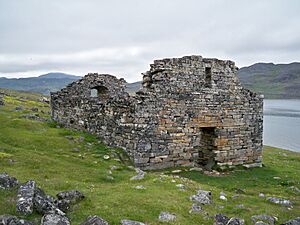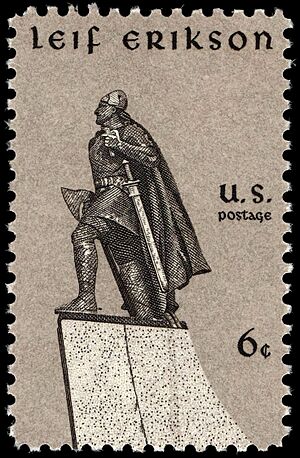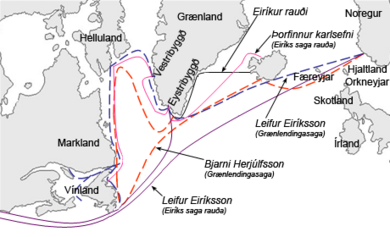Vinland facts for kids
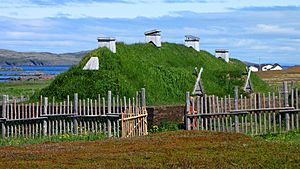
Vinland was a part of coastal North America explored by Vikings around 1000 AD. This was nearly 500 years before Christopher Columbus and John Cabot sailed to the Americas. The name "Vinland" appears in old Viking stories called the Vinland Sagas. These stories describe an area that includes parts of Newfoundland and the Gulf of Saint Lawrence, reaching into northeastern New Brunswick. What the sagas say about the land matches what we know today about traveling across the Atlantic and about North America.
In 1960, archaeologists found proof of the only known Viking site in North America. This site, called L'Anse aux Meadows, is on the northern tip of Newfoundland. Before this discovery, Vinland was only known from the old sagas and history books. The find at L'Anse aux Meadows proved that Vikings explored mainland North America long before Columbus. Some experts think L'Anse aux Meadows might be the camp called Straumfjörð in the Saga of Erik the Red.
Contents
What Does "Vinland" Mean?
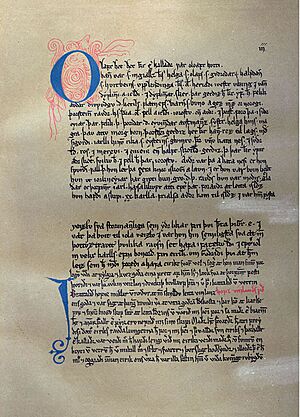
The name Vinland was given to this part of North America by the Icelandic Viking, Leif Erikson, around 1000 AD. It was also spelled Winland by a writer named Adam of Bremen in his book from about 1075. Adam heard about Winland from King Svend Estridson, who knew a lot about the northern lands.
The meaning of the name "Vinland" has been debated. Most people thought it meant "wine-land" because of the Old Norse word vín, which means "wine." Adam of Bremen wrote that grapevines grew there, making good wine. The 13th-century Grœnlendinga saga also says Vinland was named for vínber, which means "wineberry" (grapes or currants) found there.
However, some scholars think "Vinland" might mean "pasture-land" or "meadow-land." This comes from another Old Norse word, vin, which means "meadow." This idea was suggested in 1898. It's still a topic of discussion among experts today.
The Vinland Sagas: Viking Stories
The main information about Viking trips to Vinland comes from two old Icelandic stories. These are the Saga of Erik the Red and the Saga of the Greenlanders. Together, they are known as the Vinland Sagas. These stories were passed down by word of mouth for about 250 years before they were written down.
These two sagas tell similar stories but have some differences. For example, they both mention men named Bjarni who get lost at sea. The sagas say many Vikings visited Vinland. For instance, Thorfinn Karlsefni's group had 140 or 160 people in one saga, and 60 in another. Leif Erikson led 35 people, and his brother Thorvald led 30.
According to the Saga of Erik the Red, Thorfinn Karlsefni and 160 men sailed south from Greenland. They found a land of flat stones (Helluland), then a land of forests (Markland). After more sailing, they reached a place called Hóp, which was very rich in resources and had no snow in winter. However, they decided to return home after a few years because they kept having conflicts with the native people.
This saga mentions Vinland in a few ways. It says Leif Erikson found Vinland. Karlsefni's men found "vín-ber" (wineberries) near the Wonderstrands. The story also places Vinland south of Markland.
The Saga of the Greenlanders

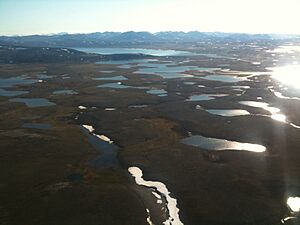
In the Saga of the Greenlanders, a Viking named Bjarni Herjólfsson accidentally found the new land around 986 AD. He was sailing from Norway to Greenland to see his father. When he finally reached Greenland, he told his story. This inspired Leif Erikson to lead an expedition.
Leif followed Bjarni's route backward. He passed a land of flat stones (Helluland) and a land of forests (Markland). After two more days at sea, they found a headland with an island nearby. They landed and built a base, which might be L'Anse aux Meadows. The saga says the winter there was mild. One day, an old servant named Tyrker found grapes or currants. In the spring, Leif returned to Greenland with timber and grapes.
Leif's brother, Thorvald, led a second trip with about 40 men. They stayed at the new base, called Leifsbúðir (Leif's shelters), for three winters. They explored the west and east coasts. On the east coast, their ship ran aground, and they lost its keel. They named that spot Keel Point (Kjalarnes). Further south, they met local people (called Skrælingjar) and fought them. Thorvald was killed by an arrow. After this, the Vikings decided to go back to Greenland.
Later, Leif's other brother, Thorstein, tried to bring Thorvald's body home but got lost at sea. He died of a disease in Greenland. His widow, Gudrid, then married Thorfinn Karlsefni. They led a large expedition to Vinland, bringing livestock. They found a beached whale that helped them survive the winter. Local people visited them and traded goods for milk. Gudrid gave birth to a son, Snorri, there. Later, a conflict with the local people led to a fight, and the Vikings decided to return to Greenland.
The saga also tells of Freydis, Erik the Red's daughter, who led another trip. She caused trouble by tricking and killing some Icelandic sailors. This was the last Vinland trip mentioned in this saga.
The Saga of Erik the Red
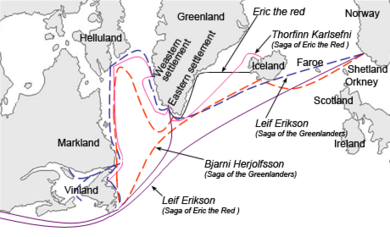
In the Saga of Erik the Red, Leif Erikson accidentally found the new land while sailing from Norway back to Greenland. He was bringing Christianity to the colony. He returned to Greenland with samples of grapes, wheat, and timber.
The next spring, Leif's brother Thorstein tried to sail to the new land but got lost. He died in Greenland. His widow, Gudrid, then married Thorfinn Karlsefni. Karlsefni, with his business partner Snorri Thorbrandsson, decided to lead a big trip to the new land, taking animals with them. Leif's brother Thorvald and sister Freydis also joined.
They sailed past lands of flat stones (Helluland) and forests (Markland). They rounded a cape where they saw a boat's keel (Kjalarnes). Then they passed very long beaches (Furðustrandir) before landing. They sent two men to explore inland, who returned with grapes and wheat. They set up camp at an inlet with strong currents (Straumfjörð). The winter was harsh, and food was scarce. They found a beached whale, but eating it made them sick.
When spring came, some wanted to sail north, while Karlsefni wanted to sail south. Karlsefni sailed south along the east coast and set up a settlement called Hóp. This land had many grapes and wheat. The saga is unsure if they stayed there for a winter or just a few weeks.
Karlsefni and Thorvald Erikson sailed further south. They met a "one-footed man" who shot Thorvald, killing him. Later, in Markland, they met five native people and took two boys, teaching them their language. The explorers returned to Straumsfjord. Disagreements led them to leave the area. On the way home, one ship was damaged by sea worms, and only those who escaped in a special boat survived. This was the last Vinland trip recorded in this saga.
Old Maps and Writings
The oldest known written record of Vinland is from a book by Adam of Bremen around 1075. He heard about these "islands" from the Danish king.
Another writer, Galvano Fiamma, from Southern Europe, mentioned Markland in his book Cronica universalis. He is thought to be the first Southern European to write about the New World.
The earliest map of Vinland was drawn by Sigurd Stefansson in Iceland around 1570. It showed Vinland in a place that could be Chesapeake Bay, St. Lawrence, or Cape Cod Bay.
Some medieval English books also mentioned a place called Wintland. They were confused about its location. Some maps showed it near Iceland but too close to Scandinavia. These books said the people there could tie up the wind in knotted cords and sell them to sailors! They didn't mention grapes, only grass and trees.
Icelandic texts from around the same time had a clearer picture. They described lands north of Iceland: a barren plain, then Greenland, then Helluland, Markland, and Vinland to the west and south. They didn't know how far south Vinland went, even guessing it might reach Africa.
Later Viking Journeys
Icelandic records show another attempt to visit Vinland from Greenland in 1121. A bishop named Eric Gnupsson "went to seek Vinland." We don't know what happened to him.
In 1347, a ship arrived in Iceland. It had been blown off course while returning to Greenland from Markland with timber. This suggests that the Greenland Vikings continued to get timber from Markland for many centuries.
Life in Vinland for Vikings
The Vikings in Vinland relied on resources like wheat, berries, wine, and fish. The "wheat" they found was likely a plant called sandwort, not the wheat we usually think of. The "grapes" were native North American grapes, as European grapes were not in the New World before the Vikings arrived. The sagas mention a river and a lake full of fish, especially salmon, which were larger than any they had seen before.
Before coming to North America, the Vikings in Greenland had to import most of their timber from Norway. Finding plenty of wood in Vinland and Markland was a huge help for them.
Other Possible Viking Finds
A real 11th-century Norwegian silver coin, called a Maine penny, was found in Maine. However, some people wonder if it was placed there as a trick. Many other objects believed to be from Vikings have been found in Canada, especially on Baffin Island and in northern Labrador.
Some stones with Viking writing (runes) have been found south of the St. Lawrence River. The Kensington Runestone in Minnesota is generally thought to be a hoax. The Spirit Pond runestones in Maine are also questioned. Other examples include the Heavener Runestone. The age and origin of these stones are debated, and none have been clearly linked to a medieval Viking presence.
A place called Point Rosee on the southwest coast of Newfoundland was once thought to be a Viking settlement. It was found using satellite images in 2014. However, after more study in 2017, experts found no proof of Vikings or any human activity there before modern times.
|
See also
 In Spanish: Vinland para niños
In Spanish: Vinland para niños


